Macroeconomics Assignment: Exchange Rate and Economic Factors
VerifiedAdded on 2022/09/15
|10
|1357
|20
Homework Assignment
AI Summary
This economics assignment delves into the intricacies of exchange rate mechanisms within a macroeconomic framework, using the fictional currency of Eriador (dory) and the US dollar as a case study. It begins by illustrating the equilibrium point in a flexible exchange rate system, where the value of the dory is determined by global macroeconomic variables. The analysis then explores flexible exchange rate systems, demonstrating how changes in demand and supply for the USD impact the exchange rate. The assignment contrasts this with fixed exchange rate regimes, where the central bank intervenes to maintain the currency's value. The impact of various economic factors, including inflation rates, labor costs, interest rate adjustments, and changes in demand for bonds, on the exchange rate is also examined with accompanying figures to support the analysis. The assignment utilizes diagrams to illustrate key concepts such as appreciation, depreciation, and the effects of monetary policy interventions, providing a comprehensive understanding of the complex relationship between macroeconomic variables and exchange rates.
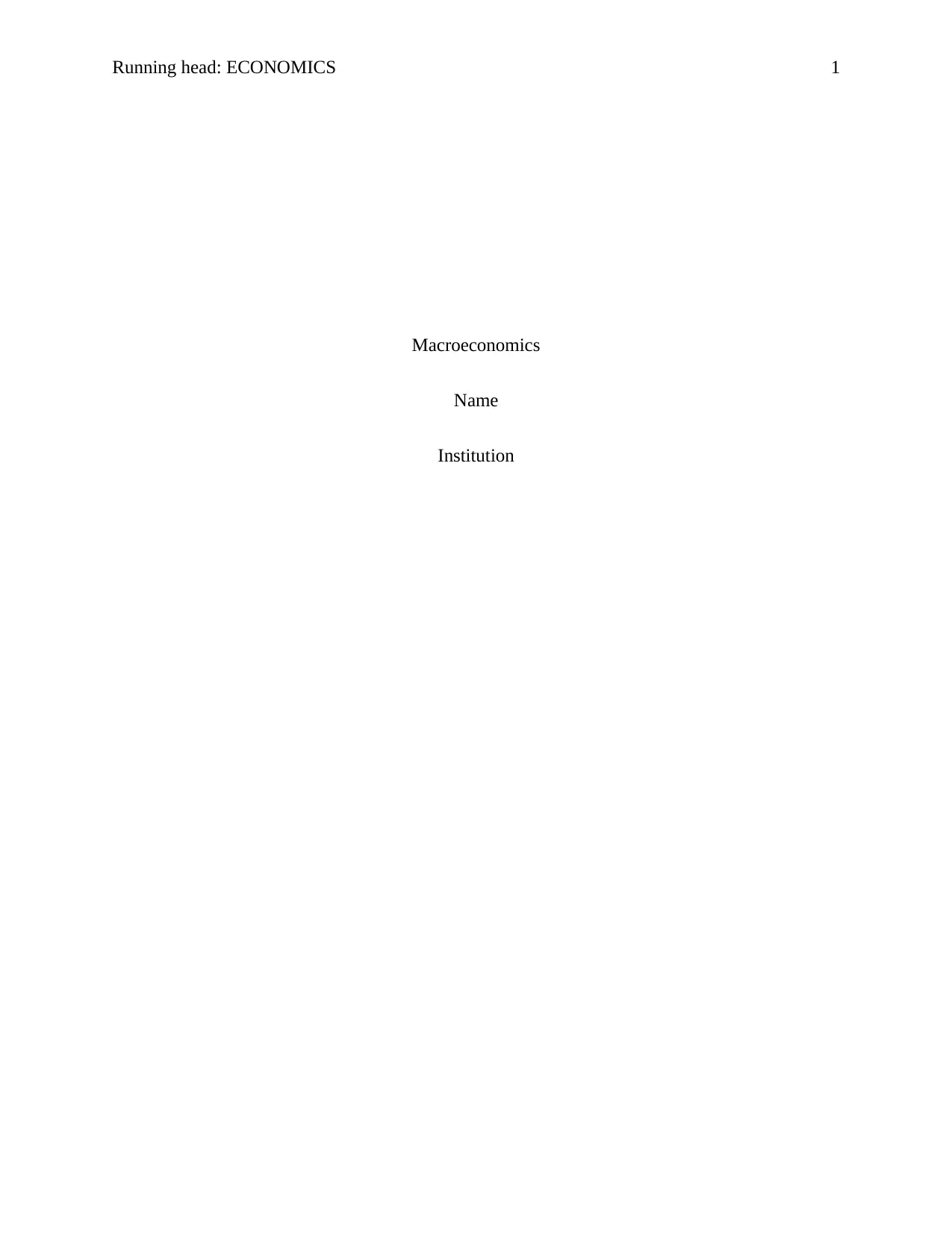
Running head: ECONOMICS 1
Macroeconomics
Name
Institution
Macroeconomics
Name
Institution
Paraphrase This Document
Need a fresh take? Get an instant paraphrase of this document with our AI Paraphraser
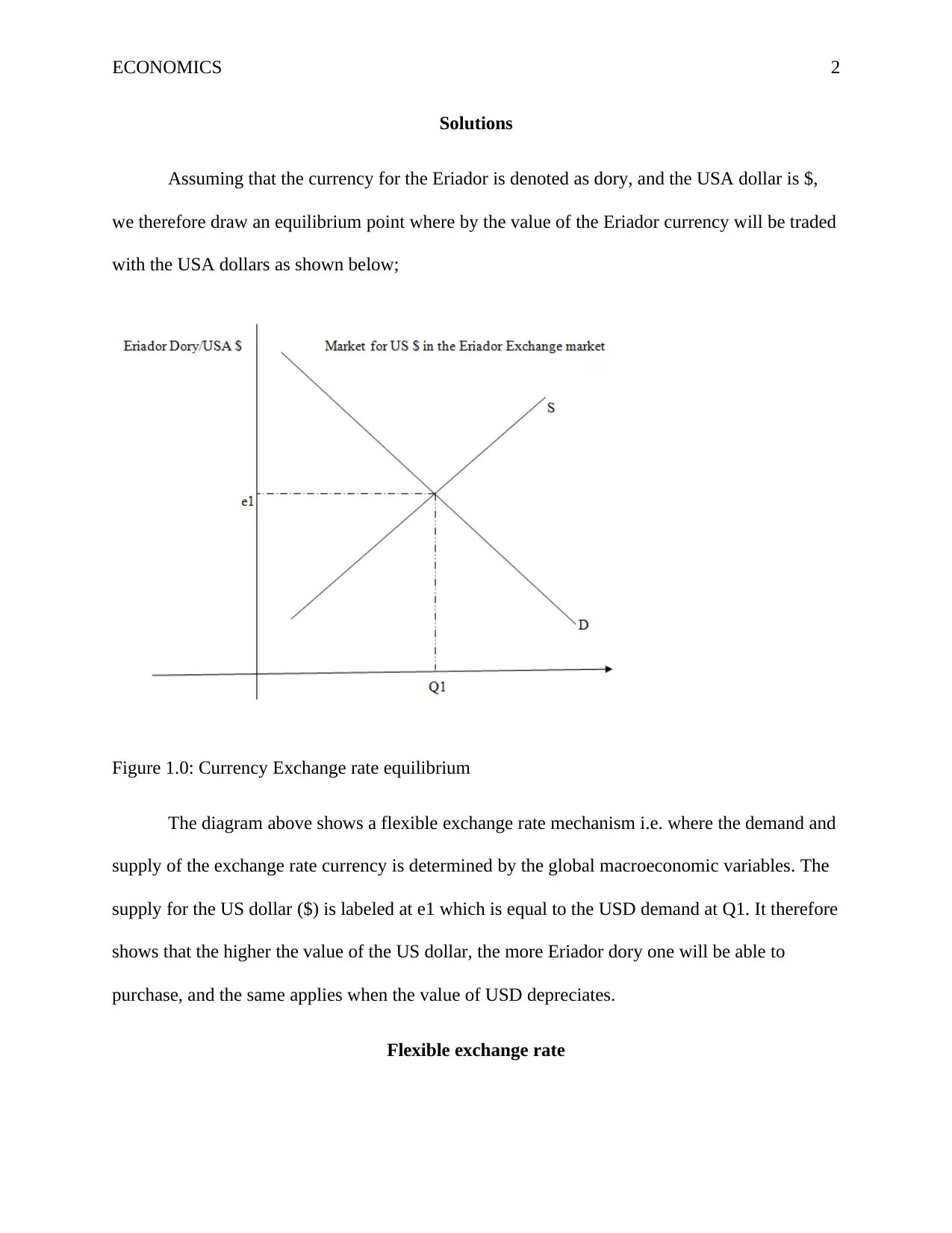
ECONOMICS 2
Solutions
Assuming that the currency for the Eriador is denoted as dory, and the USA dollar is $,
we therefore draw an equilibrium point where by the value of the Eriador currency will be traded
with the USA dollars as shown below;
Figure 1.0: Currency Exchange rate equilibrium
The diagram above shows a flexible exchange rate mechanism i.e. where the demand and
supply of the exchange rate currency is determined by the global macroeconomic variables. The
supply for the US dollar ($) is labeled at e1 which is equal to the USD demand at Q1. It therefore
shows that the higher the value of the US dollar, the more Eriador dory one will be able to
purchase, and the same applies when the value of USD depreciates.
Flexible exchange rate
Solutions
Assuming that the currency for the Eriador is denoted as dory, and the USA dollar is $,
we therefore draw an equilibrium point where by the value of the Eriador currency will be traded
with the USA dollars as shown below;
Figure 1.0: Currency Exchange rate equilibrium
The diagram above shows a flexible exchange rate mechanism i.e. where the demand and
supply of the exchange rate currency is determined by the global macroeconomic variables. The
supply for the US dollar ($) is labeled at e1 which is equal to the USD demand at Q1. It therefore
shows that the higher the value of the US dollar, the more Eriador dory one will be able to
purchase, and the same applies when the value of USD depreciates.
Flexible exchange rate
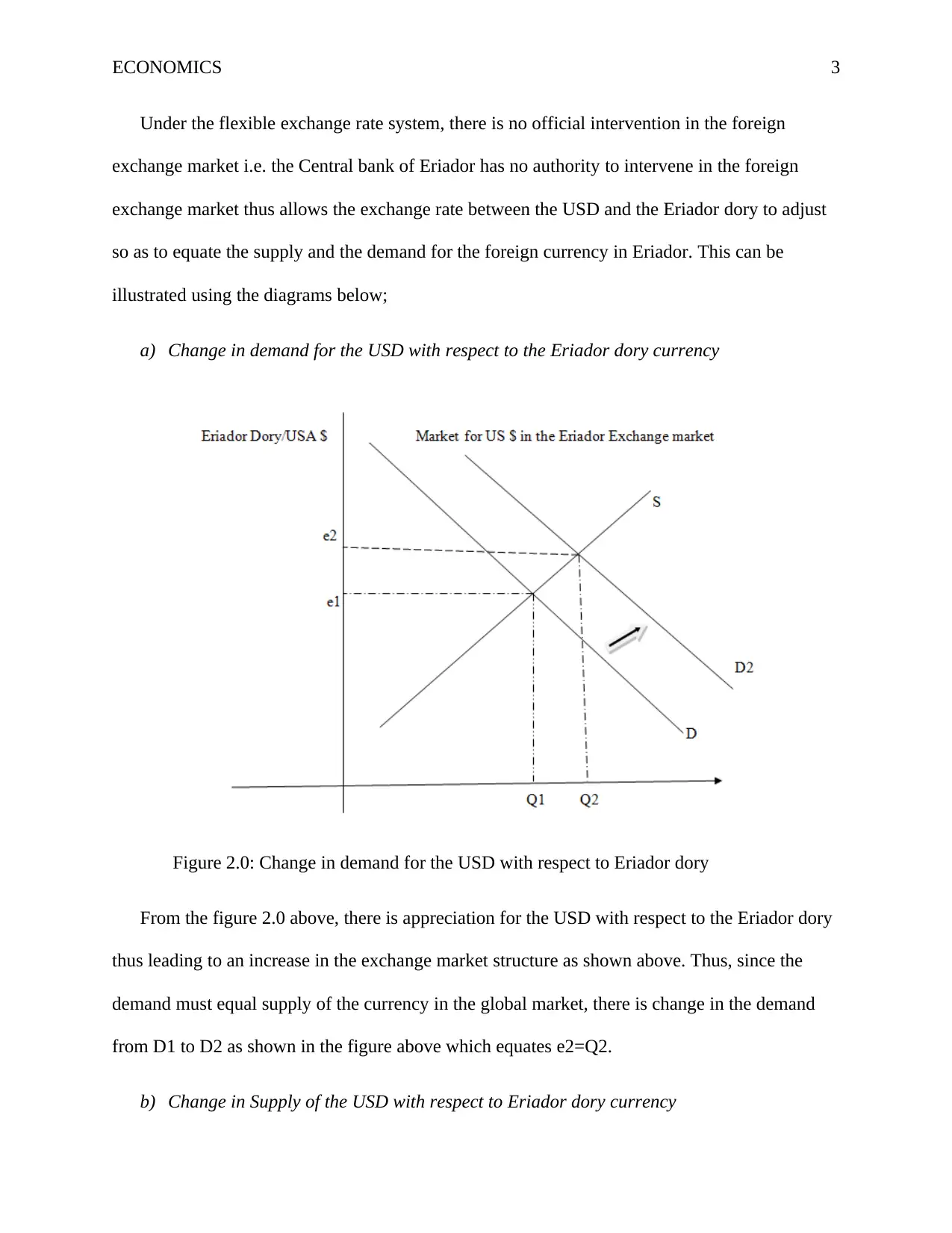
ECONOMICS 3
Under the flexible exchange rate system, there is no official intervention in the foreign
exchange market i.e. the Central bank of Eriador has no authority to intervene in the foreign
exchange market thus allows the exchange rate between the USD and the Eriador dory to adjust
so as to equate the supply and the demand for the foreign currency in Eriador. This can be
illustrated using the diagrams below;
a) Change in demand for the USD with respect to the Eriador dory currency
Figure 2.0: Change in demand for the USD with respect to Eriador dory
From the figure 2.0 above, there is appreciation for the USD with respect to the Eriador dory
thus leading to an increase in the exchange market structure as shown above. Thus, since the
demand must equal supply of the currency in the global market, there is change in the demand
from D1 to D2 as shown in the figure above which equates e2=Q2.
b) Change in Supply of the USD with respect to Eriador dory currency
Under the flexible exchange rate system, there is no official intervention in the foreign
exchange market i.e. the Central bank of Eriador has no authority to intervene in the foreign
exchange market thus allows the exchange rate between the USD and the Eriador dory to adjust
so as to equate the supply and the demand for the foreign currency in Eriador. This can be
illustrated using the diagrams below;
a) Change in demand for the USD with respect to the Eriador dory currency
Figure 2.0: Change in demand for the USD with respect to Eriador dory
From the figure 2.0 above, there is appreciation for the USD with respect to the Eriador dory
thus leading to an increase in the exchange market structure as shown above. Thus, since the
demand must equal supply of the currency in the global market, there is change in the demand
from D1 to D2 as shown in the figure above which equates e2=Q2.
b) Change in Supply of the USD with respect to Eriador dory currency
⊘ This is a preview!⊘
Do you want full access?
Subscribe today to unlock all pages.

Trusted by 1+ million students worldwide
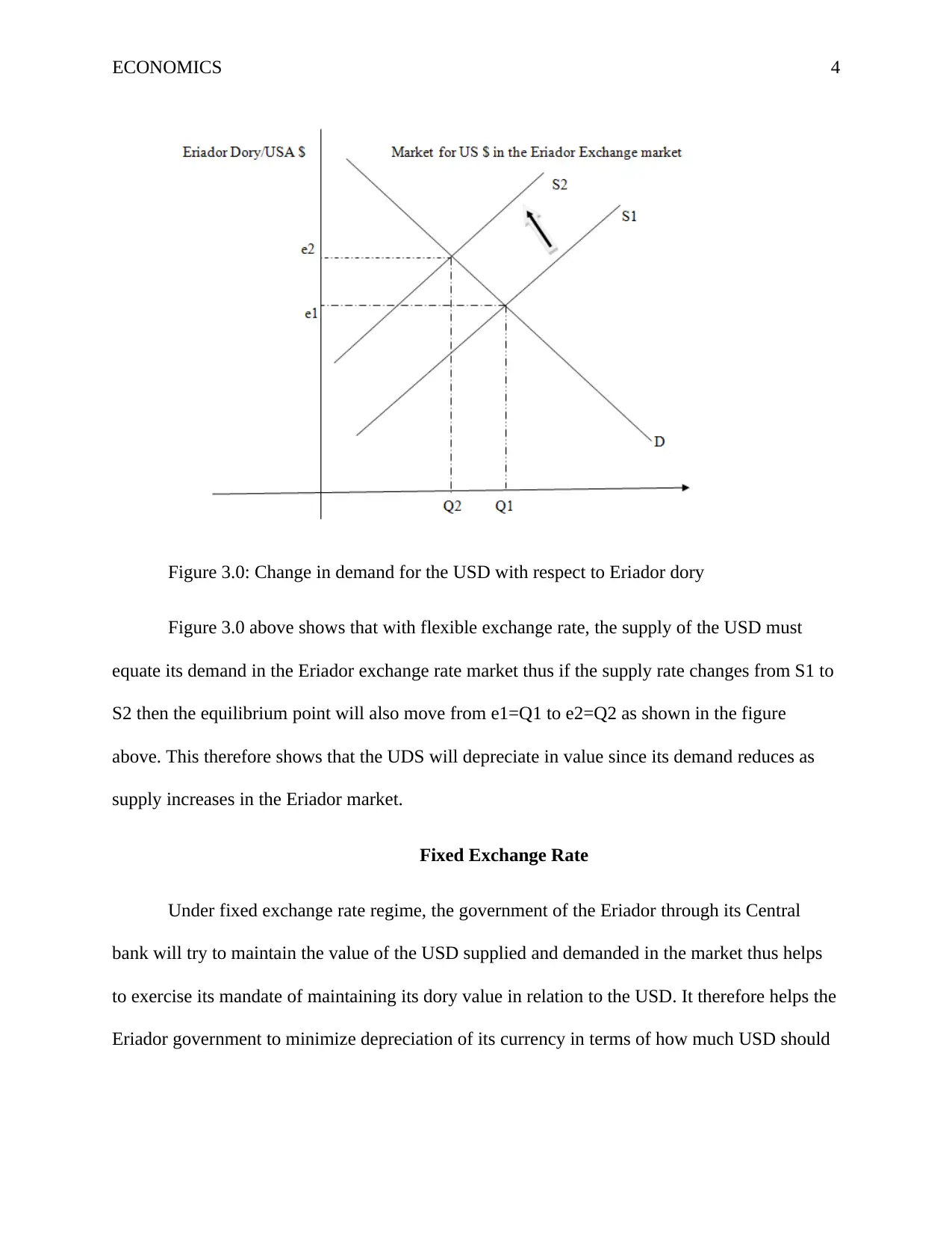
ECONOMICS 4
Figure 3.0: Change in demand for the USD with respect to Eriador dory
Figure 3.0 above shows that with flexible exchange rate, the supply of the USD must
equate its demand in the Eriador exchange rate market thus if the supply rate changes from S1 to
S2 then the equilibrium point will also move from e1=Q1 to e2=Q2 as shown in the figure
above. This therefore shows that the UDS will depreciate in value since its demand reduces as
supply increases in the Eriador market.
Fixed Exchange Rate
Under fixed exchange rate regime, the government of the Eriador through its Central
bank will try to maintain the value of the USD supplied and demanded in the market thus helps
to exercise its mandate of maintaining its dory value in relation to the USD. It therefore helps the
Eriador government to minimize depreciation of its currency in terms of how much USD should
Figure 3.0: Change in demand for the USD with respect to Eriador dory
Figure 3.0 above shows that with flexible exchange rate, the supply of the USD must
equate its demand in the Eriador exchange rate market thus if the supply rate changes from S1 to
S2 then the equilibrium point will also move from e1=Q1 to e2=Q2 as shown in the figure
above. This therefore shows that the UDS will depreciate in value since its demand reduces as
supply increases in the Eriador market.
Fixed Exchange Rate
Under fixed exchange rate regime, the government of the Eriador through its Central
bank will try to maintain the value of the USD supplied and demanded in the market thus helps
to exercise its mandate of maintaining its dory value in relation to the USD. It therefore helps the
Eriador government to minimize depreciation of its currency in terms of how much USD should
Paraphrase This Document
Need a fresh take? Get an instant paraphrase of this document with our AI Paraphraser
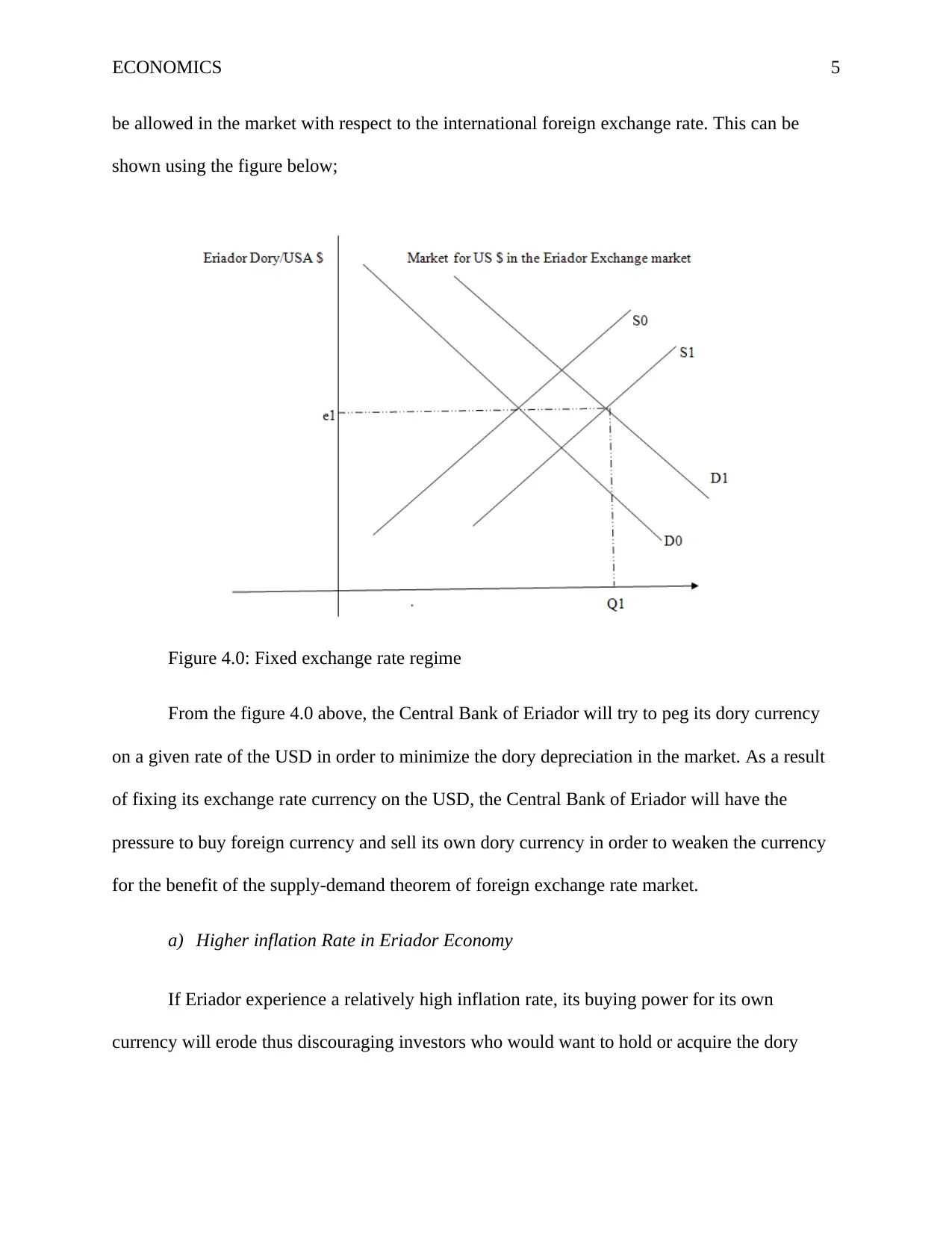
ECONOMICS 5
be allowed in the market with respect to the international foreign exchange rate. This can be
shown using the figure below;
Figure 4.0: Fixed exchange rate regime
From the figure 4.0 above, the Central Bank of Eriador will try to peg its dory currency
on a given rate of the USD in order to minimize the dory depreciation in the market. As a result
of fixing its exchange rate currency on the USD, the Central Bank of Eriador will have the
pressure to buy foreign currency and sell its own dory currency in order to weaken the currency
for the benefit of the supply-demand theorem of foreign exchange rate market.
a) Higher inflation Rate in Eriador Economy
If Eriador experience a relatively high inflation rate, its buying power for its own
currency will erode thus discouraging investors who would want to hold or acquire the dory
be allowed in the market with respect to the international foreign exchange rate. This can be
shown using the figure below;
Figure 4.0: Fixed exchange rate regime
From the figure 4.0 above, the Central Bank of Eriador will try to peg its dory currency
on a given rate of the USD in order to minimize the dory depreciation in the market. As a result
of fixing its exchange rate currency on the USD, the Central Bank of Eriador will have the
pressure to buy foreign currency and sell its own dory currency in order to weaken the currency
for the benefit of the supply-demand theorem of foreign exchange rate market.
a) Higher inflation Rate in Eriador Economy
If Eriador experience a relatively high inflation rate, its buying power for its own
currency will erode thus discouraging investors who would want to hold or acquire the dory
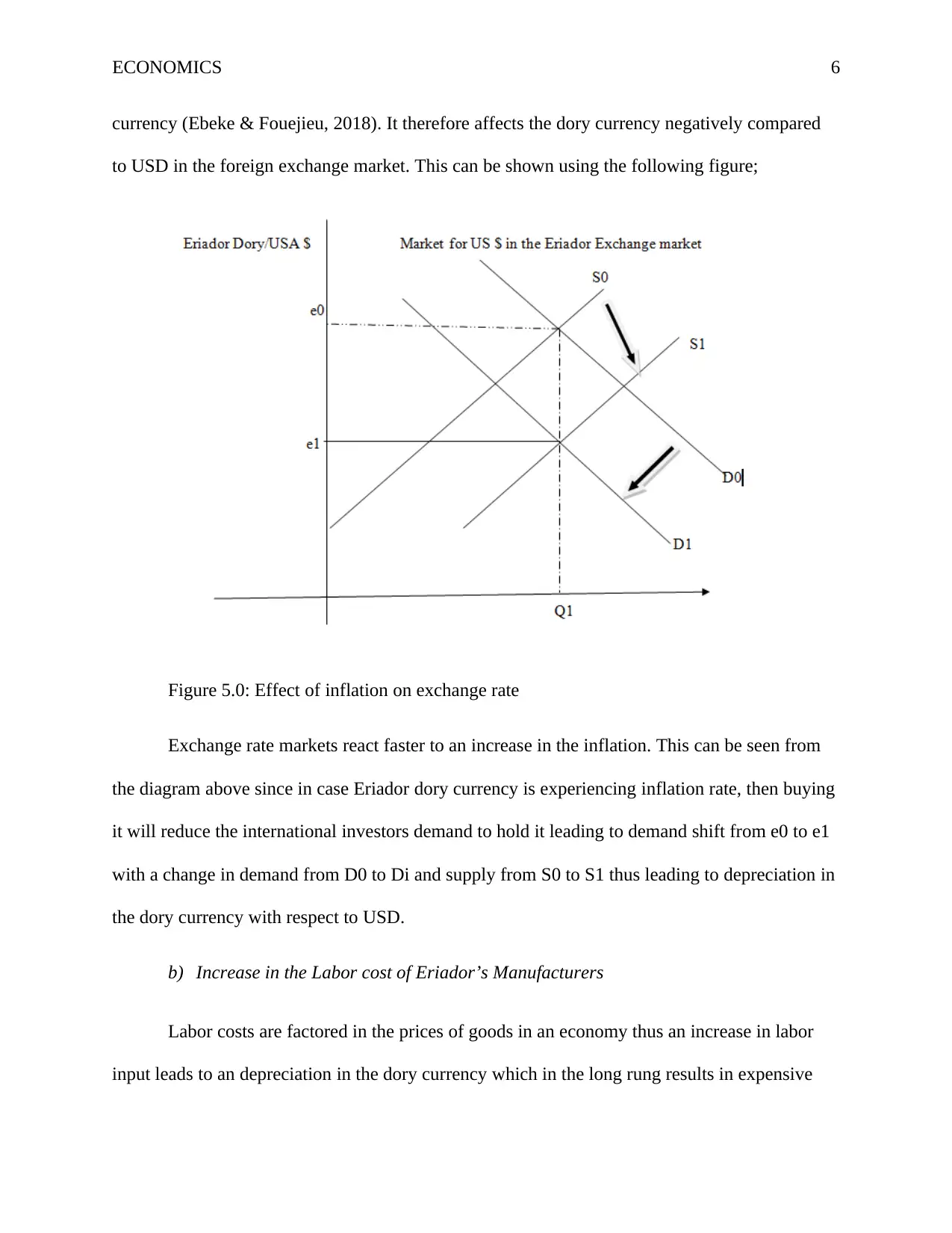
ECONOMICS 6
currency (Ebeke & Fouejieu, 2018). It therefore affects the dory currency negatively compared
to USD in the foreign exchange market. This can be shown using the following figure;
Figure 5.0: Effect of inflation on exchange rate
Exchange rate markets react faster to an increase in the inflation. This can be seen from
the diagram above since in case Eriador dory currency is experiencing inflation rate, then buying
it will reduce the international investors demand to hold it leading to demand shift from e0 to e1
with a change in demand from D0 to Di and supply from S0 to S1 thus leading to depreciation in
the dory currency with respect to USD.
b) Increase in the Labor cost of Eriador’s Manufacturers
Labor costs are factored in the prices of goods in an economy thus an increase in labor
input leads to an depreciation in the dory currency which in the long rung results in expensive
currency (Ebeke & Fouejieu, 2018). It therefore affects the dory currency negatively compared
to USD in the foreign exchange market. This can be shown using the following figure;
Figure 5.0: Effect of inflation on exchange rate
Exchange rate markets react faster to an increase in the inflation. This can be seen from
the diagram above since in case Eriador dory currency is experiencing inflation rate, then buying
it will reduce the international investors demand to hold it leading to demand shift from e0 to e1
with a change in demand from D0 to Di and supply from S0 to S1 thus leading to depreciation in
the dory currency with respect to USD.
b) Increase in the Labor cost of Eriador’s Manufacturers
Labor costs are factored in the prices of goods in an economy thus an increase in labor
input leads to an depreciation in the dory currency which in the long rung results in expensive
⊘ This is a preview!⊘
Do you want full access?
Subscribe today to unlock all pages.

Trusted by 1+ million students worldwide
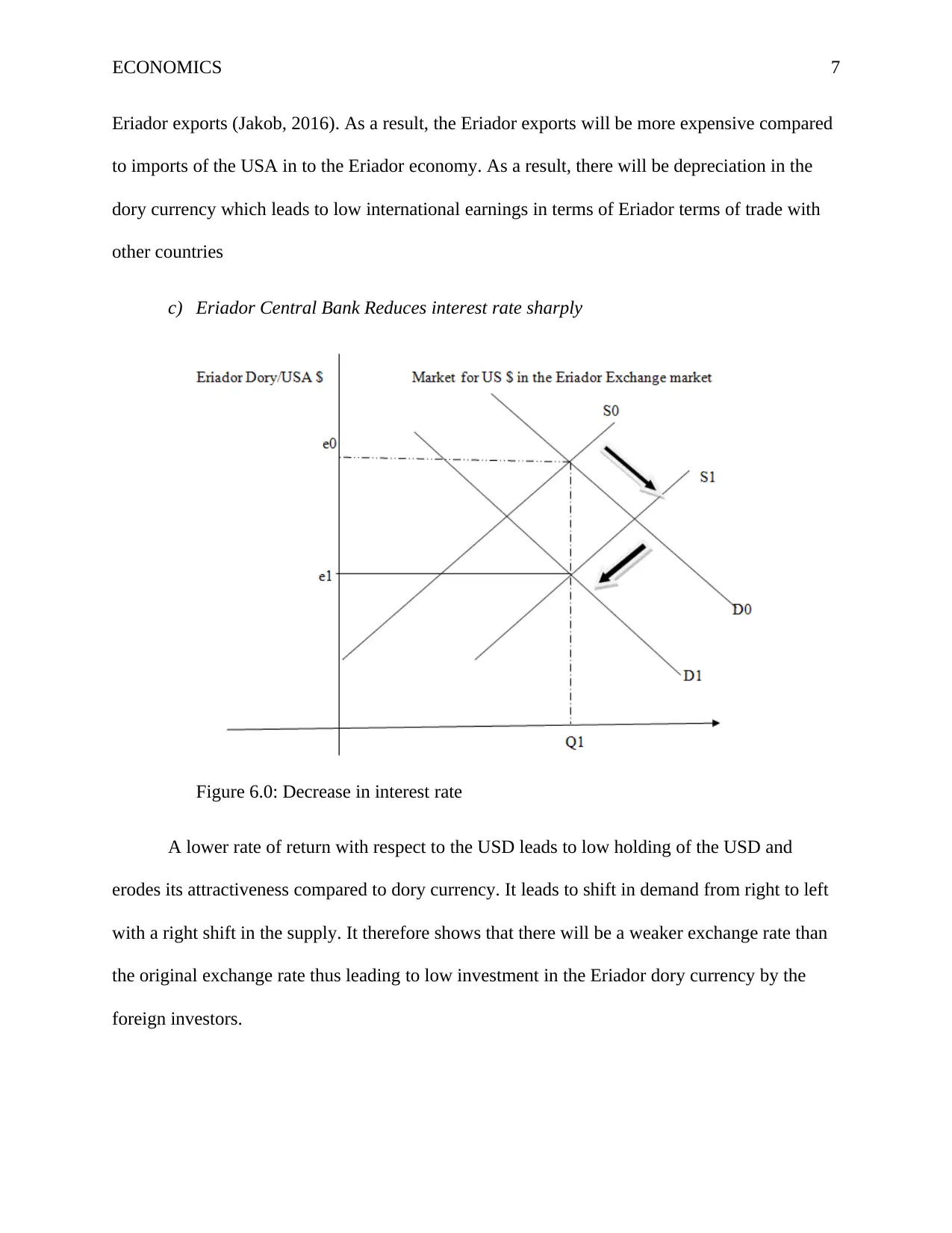
ECONOMICS 7
Eriador exports (Jakob, 2016). As a result, the Eriador exports will be more expensive compared
to imports of the USA in to the Eriador economy. As a result, there will be depreciation in the
dory currency which leads to low international earnings in terms of Eriador terms of trade with
other countries
c) Eriador Central Bank Reduces interest rate sharply
Figure 6.0: Decrease in interest rate
A lower rate of return with respect to the USD leads to low holding of the USD and
erodes its attractiveness compared to dory currency. It leads to shift in demand from right to left
with a right shift in the supply. It therefore shows that there will be a weaker exchange rate than
the original exchange rate thus leading to low investment in the Eriador dory currency by the
foreign investors.
Eriador exports (Jakob, 2016). As a result, the Eriador exports will be more expensive compared
to imports of the USA in to the Eriador economy. As a result, there will be depreciation in the
dory currency which leads to low international earnings in terms of Eriador terms of trade with
other countries
c) Eriador Central Bank Reduces interest rate sharply
Figure 6.0: Decrease in interest rate
A lower rate of return with respect to the USD leads to low holding of the USD and
erodes its attractiveness compared to dory currency. It leads to shift in demand from right to left
with a right shift in the supply. It therefore shows that there will be a weaker exchange rate than
the original exchange rate thus leading to low investment in the Eriador dory currency by the
foreign investors.
Paraphrase This Document
Need a fresh take? Get an instant paraphrase of this document with our AI Paraphraser
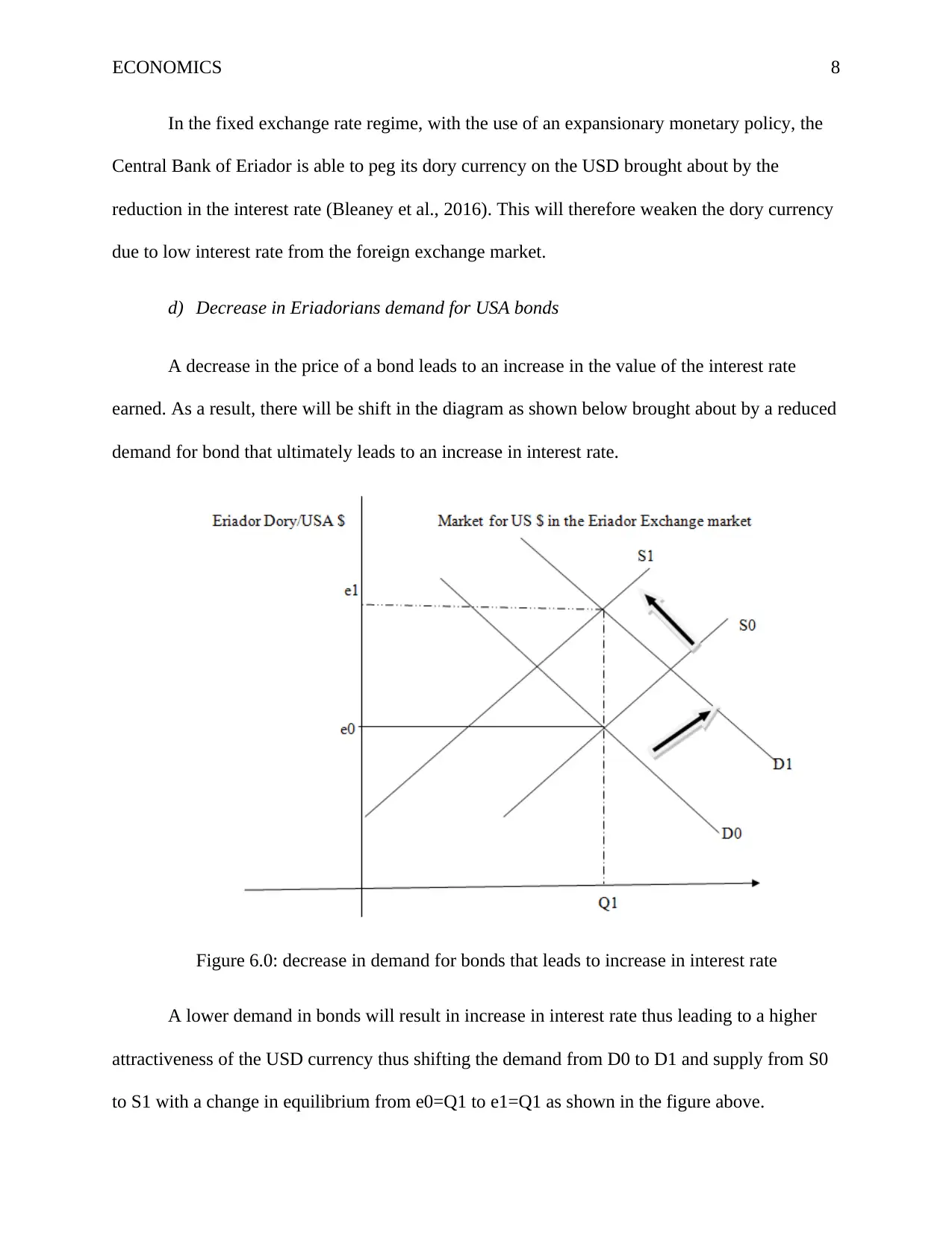
ECONOMICS 8
In the fixed exchange rate regime, with the use of an expansionary monetary policy, the
Central Bank of Eriador is able to peg its dory currency on the USD brought about by the
reduction in the interest rate (Bleaney et al., 2016). This will therefore weaken the dory currency
due to low interest rate from the foreign exchange market.
d) Decrease in Eriadorians demand for USA bonds
A decrease in the price of a bond leads to an increase in the value of the interest rate
earned. As a result, there will be shift in the diagram as shown below brought about by a reduced
demand for bond that ultimately leads to an increase in interest rate.
Figure 6.0: decrease in demand for bonds that leads to increase in interest rate
A lower demand in bonds will result in increase in interest rate thus leading to a higher
attractiveness of the USD currency thus shifting the demand from D0 to D1 and supply from S0
to S1 with a change in equilibrium from e0=Q1 to e1=Q1 as shown in the figure above.
In the fixed exchange rate regime, with the use of an expansionary monetary policy, the
Central Bank of Eriador is able to peg its dory currency on the USD brought about by the
reduction in the interest rate (Bleaney et al., 2016). This will therefore weaken the dory currency
due to low interest rate from the foreign exchange market.
d) Decrease in Eriadorians demand for USA bonds
A decrease in the price of a bond leads to an increase in the value of the interest rate
earned. As a result, there will be shift in the diagram as shown below brought about by a reduced
demand for bond that ultimately leads to an increase in interest rate.
Figure 6.0: decrease in demand for bonds that leads to increase in interest rate
A lower demand in bonds will result in increase in interest rate thus leading to a higher
attractiveness of the USD currency thus shifting the demand from D0 to D1 and supply from S0
to S1 with a change in equilibrium from e0=Q1 to e1=Q1 as shown in the figure above.
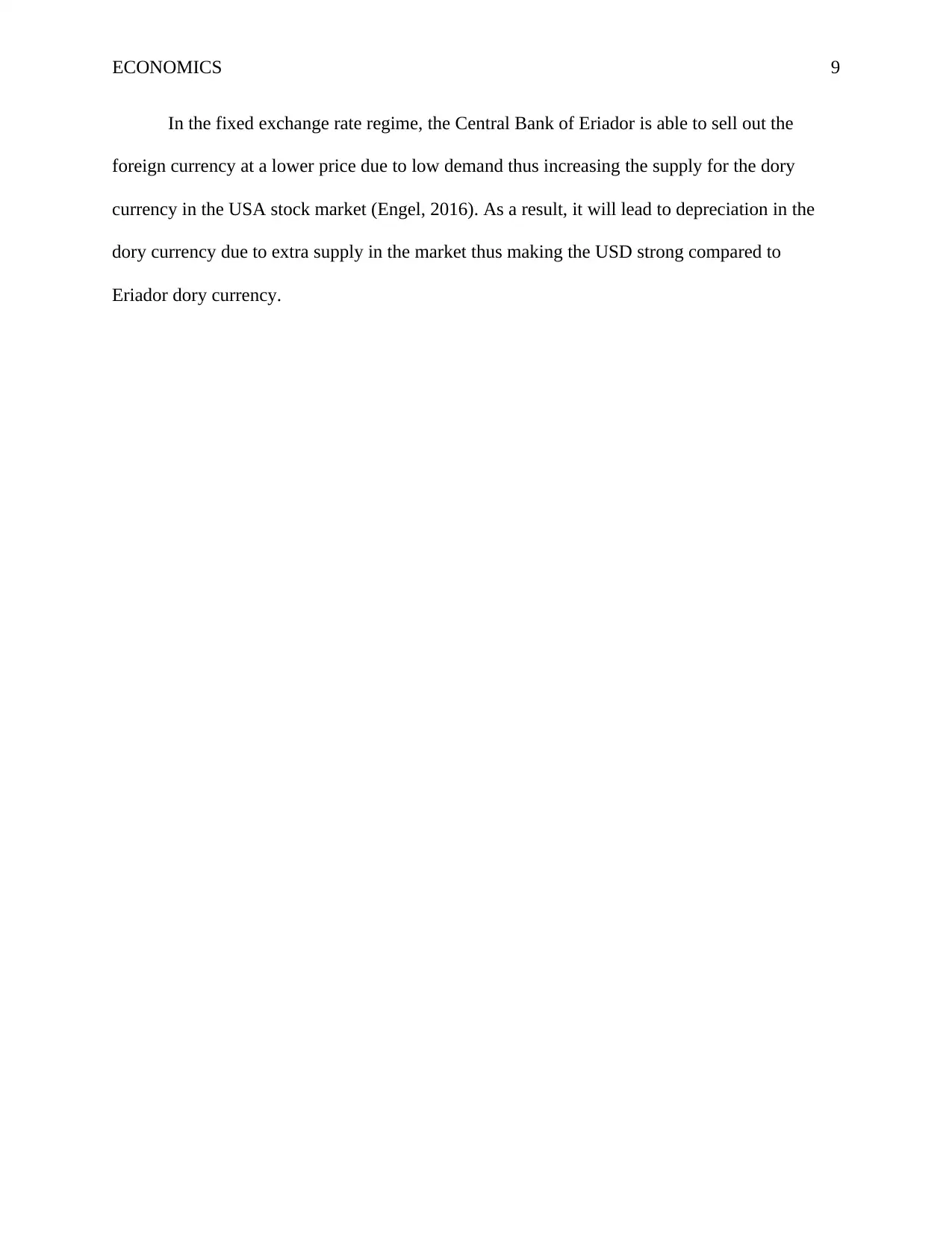
ECONOMICS 9
In the fixed exchange rate regime, the Central Bank of Eriador is able to sell out the
foreign currency at a lower price due to low demand thus increasing the supply for the dory
currency in the USA stock market (Engel, 2016). As a result, it will lead to depreciation in the
dory currency due to extra supply in the market thus making the USD strong compared to
Eriador dory currency.
In the fixed exchange rate regime, the Central Bank of Eriador is able to sell out the
foreign currency at a lower price due to low demand thus increasing the supply for the dory
currency in the USA stock market (Engel, 2016). As a result, it will lead to depreciation in the
dory currency due to extra supply in the market thus making the USD strong compared to
Eriador dory currency.
⊘ This is a preview!⊘
Do you want full access?
Subscribe today to unlock all pages.

Trusted by 1+ million students worldwide
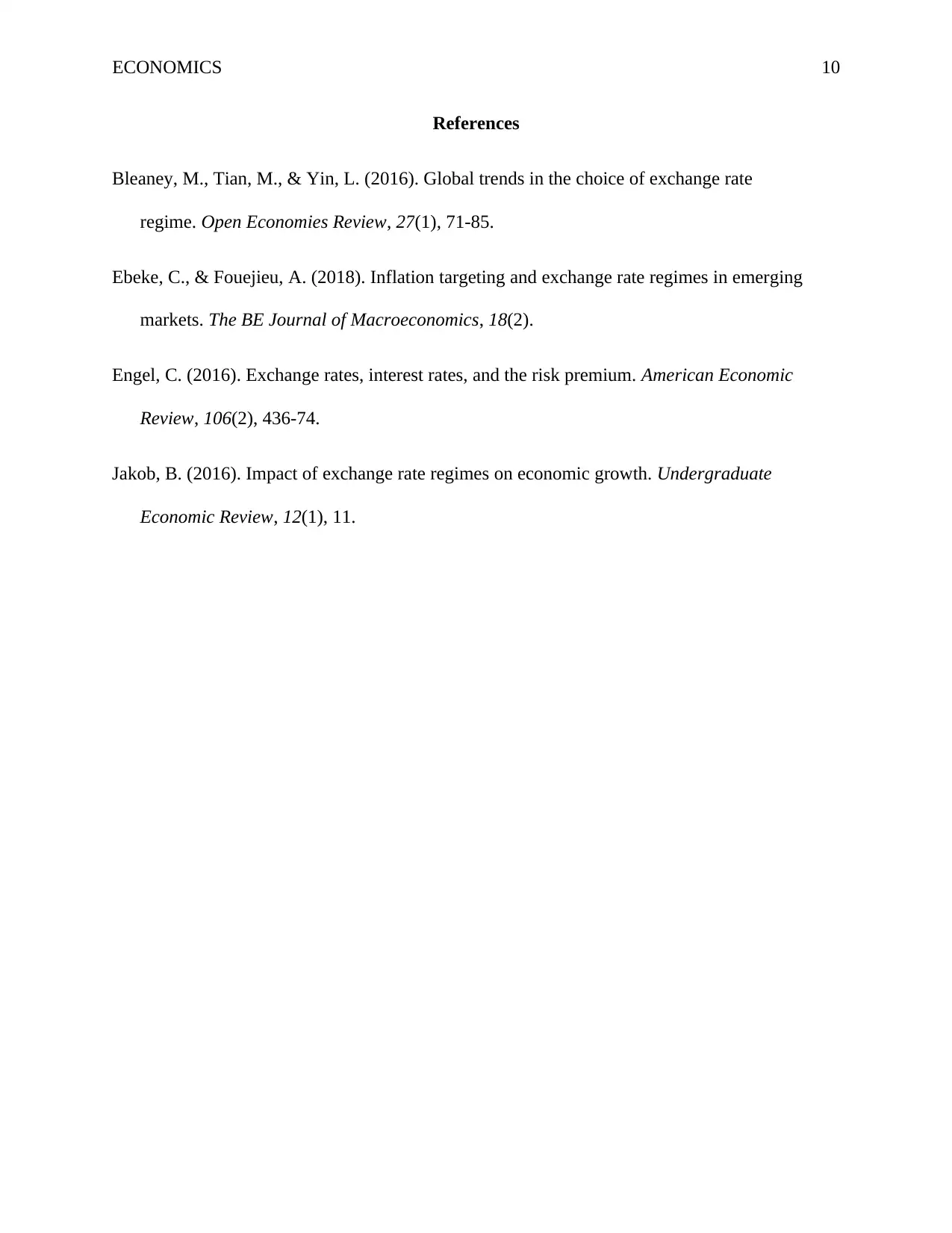
ECONOMICS 10
References
Bleaney, M., Tian, M., & Yin, L. (2016). Global trends in the choice of exchange rate
regime. Open Economies Review, 27(1), 71-85.
Ebeke, C., & Fouejieu, A. (2018). Inflation targeting and exchange rate regimes in emerging
markets. The BE Journal of Macroeconomics, 18(2).
Engel, C. (2016). Exchange rates, interest rates, and the risk premium. American Economic
Review, 106(2), 436-74.
Jakob, B. (2016). Impact of exchange rate regimes on economic growth. Undergraduate
Economic Review, 12(1), 11.
References
Bleaney, M., Tian, M., & Yin, L. (2016). Global trends in the choice of exchange rate
regime. Open Economies Review, 27(1), 71-85.
Ebeke, C., & Fouejieu, A. (2018). Inflation targeting and exchange rate regimes in emerging
markets. The BE Journal of Macroeconomics, 18(2).
Engel, C. (2016). Exchange rates, interest rates, and the risk premium. American Economic
Review, 106(2), 436-74.
Jakob, B. (2016). Impact of exchange rate regimes on economic growth. Undergraduate
Economic Review, 12(1), 11.
1 out of 10
Related Documents
Your All-in-One AI-Powered Toolkit for Academic Success.
+13062052269
info@desklib.com
Available 24*7 on WhatsApp / Email
![[object Object]](/_next/static/media/star-bottom.7253800d.svg)
Unlock your academic potential
Copyright © 2020–2025 A2Z Services. All Rights Reserved. Developed and managed by ZUCOL.





